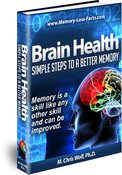Agnosia and Memory Loss:
Peculiar Effects of Brain Injury
By M. CHRIS WOLF, PH.D.
Founder & Editor-in-Chief
Agnosia (ag•no•sia) (AG) is a general term for a loss of capacity to recognize people, objects, shapes, sounds, or even smells.
This difficulty is not related to a problem with the primary sense organ (e.g. vision or hearing) or our attention.
In essence, the person does not have the ability to recognize things that were previously recognized without a difficulty.
Often times this occurs with either vision or auditory (hearing) recognition of objects. Memory is affected because the person cannot recognize previously recognizable stimuli.
In this article, we will briefly review some of the most common (AG). We will provide you with some information about this interesting effect of some brain injuries.
Auditory AG refers to the person’s inability to recognize a sound despite the fact that there is not a defect of the ear. The person can hear the sound but cannot recognize it. That is, they can not associate it with the correct word.
Visual AG refers to the inability to recognize visual objects in the field of vision. This may take the form of being unable to recognize shapes or objects.
Auditory sound AG is the inability of the person to recognize non-speech sounds such as the bark of a dog or the horn of a car.
Astereognosis means that the person cannot recognize an object by its weight, size, shape or even an object’s texture.
Prosopanosia refers to the inability to recognize a previously familiar face. The person maintains the ability to recognize the person by others means such as their speech.
Dr. Oliver Sachs in his popular book The Man Who Mistook His Wife For A Hat: And Other Clinical Tales reviews a very interesting cases involving prosopanosia and other forms of agnosia.
Color AG is when the person cannot recognize color despite intact color discrimination. This is different from color blindness which relates to poor color discrimination.
Tactile AG is present when the person cannot recognize an object by touch but can by texture or shape.
All of the above are important within the context of memory because if we are not able to perceive or integrate information properly it will not be retained or recalled well.
From my perspective these misperceptions are one of the most facilitating aspects of neuropsychology, neurology and brain functioning.
For more inforamtion on (AG) try these resources:
Visual Agnosia (Bradford Books by Martha J. Farah
Phantoms in the Brain: Probing the Mysteries of the Human Mind by V. S. Ramachandran, Sandra Blakeslee, Oliver Sacks
The Mind's Eye by Oliver Sacks
Return from Agnosia and Memory Loss to Brain Injury Symptoms
Our Sponsors



Click Here Now
LIKE THIS SITE?
Interested in having your own internet home based business?





